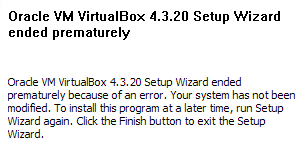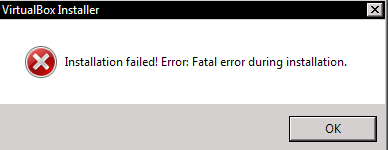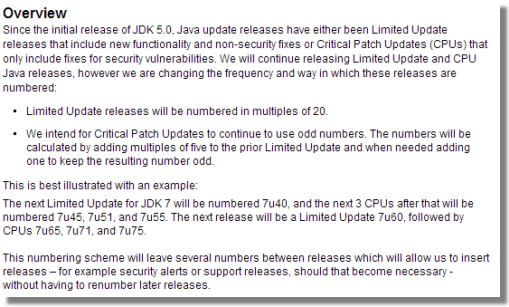This blog post is from 2011 but I found it really though-provoking. Yes, I agree with most of it.
http://hepburndata.blogspot.com/2011/12/perspective-is-everything-why-even-most.html
Areas of Interest, as counted by my cat
This blog post is from 2011 but I found it really though-provoking. Yes, I agree with most of it.
http://hepburndata.blogspot.com/2011/12/perspective-is-everything-why-even-most.html
I was preparing for an Oracle online workshop on Database 12c multi-tenancy, and as part of the prep, you get to download a VM image with the lab environment. Of course, being Oracle, it is a Virtual Box vm.
Now, I like Virtual Box. It works great on my Mac at home, but for some reason I’ve had problems installing 4.x on my work laptop (Lenovo W520, getting on a bit now but still recommended).
The problem is Virtual Box almost completely installs – until it gets a certain point, then the progress bar runs backwards and it says “rolling back install”, followed by:

“Oracle VM VirtualBox 4.3.20 Setup Wizard ended prematurely” because of “an error”. This is followed up by “Installation failed! Fatal error during installation.”.

No other information provided. Running as Adminstrator after a cold reboot didn’t help.
Well… I really wanted to have the Workshop lab environment available, so despite the fact that last time I encountered this problem I didn’t find any useful help on the web, I tried again… and this time, I found something on the forums, a post by user Tronmech:
https://forums.virtualbox.org/viewtopic.php?f=6&t=61785
I’ll repeat the instructions here in case for some reason that post vanishes:
This time, the install was successful. Thanks, Tronmech!
After some more research, it seems that Windows 7 has a maximum hard-coded limit of 14 network filter drivers… and for some reason, this setting in the registry reduces it further to 8, by default.
So setting the MaxNumFilters key to 20 probably only lifts the artificial limit and allows 14 possible filters. Applications such as Virtual Machine managers and VPN clients need to add filters to the network stack, and increasing this limit in the registry seems to be the recommended fix.
In one KB article, I read that a Windows Service Pack could not be installed until some filters were removed!
To view currently deployed Network Filter Drivers, right-click on your connection widget in the Network Connections control panel applet, and view properties:
I believe that each of those checkboxed items is a “Network Filter Driver”. I have 9 of them, and I assume that the “VirtualBox Bridged Networking” driver was the 9th one added after I lifted the limit of 8.
My better half and I recently upgraded our personal computers from aging Sony Vaio laptops, to twin 2013 iMacs. We’ve wanted to dip our feet in the OS X waters for some time now, and this seemed to be a good opportunity.
I’d always supposed Apple Macs to be a paragon of typography perfection, so imagine my surprise when I discovered the great “fuzzy font” controversy surrounding recent OS X releases.
There’s a lot been written about this elsewhere so I won’t repeat it:
Anyway, the problem seems to be particularly noticeable when light text on a dark background is used. Unfortunately, this directly affects my Prodigal Sounds family of web sites.
Thanks to a post by Tim Van Damme, I found a work-around: to add a block to the web site’s CSS stylesheet:
html {
-webkit-font-smoothing: antialiased;
}
This seems to force the browser (at least, Safari and Chrome) to work as though the LCD font smoothing option was turned off, and the text is more readable for those browsing on Macs, even if they have the LCD font smoothing option enabled.
If you’re on a Mac, you can see the results here at www.prodigalsounds.com.
I found that I needed to convert some raw column names (i.e. THIS_IS_MY_COLUMN) into a human-readable “Proper” or “Title” case form, e.g. This Is My Column.
Scouring the web, I didn’t find out I could steal, so here’s my implementation:
function Proper(
p_string varchar2
) return varchar2
is
l_string varchar2(200);
l_proper varchar2(200);
begin
l_proper := '';
-- change any underscores to spaces:
l_string := replace(lower(p_string), '_',' ' );
for i in 1..length(l_string)
loop
-- obviously the first character is UPPER:
if i =1 then
l_proper := l_proper || upper( substr( l_string, i, 1 ) );
else
-- if the character is preceded by a space, UPPER it:
if substr( l_string, i-1, 1 ) = ' ' then
l_proper := l_proper || upper( substr( l_string, i, 1 ) );
else
l_proper := l_proper || substr( l_string, i, 1 );
end if;
end if;
end loop;
return l_proper;
end;
If this was April 1st, I’d be sure that this was satire, but as it is, I’m not sure:
Java SE – Change in Version Numbering scheme in March 2013
In case this vanishes off the web, here’s the gist:

Seriously? I don’t know who is to blame for this loss of sanity. Oracle, you are not so damn important that you need to re-invent this. My understanding is that there is a well-established convention for numbering incremental versions of a product, that allows for such concepts as minor feature releases and bug fix releases.
The scheme is nicely described here on Stack Overflow: How to do version numbers.
What is sad is that back in the Sun days, Java release did follow this numbering convention.
Problem
Is it possible to design a multi-tenant architecture in an Oracle DB instance, such that different customers’ data is transparently partitioned whilst keeping common code and common tables in a single location?
Possible Strategy
Consider the following architecture:
Here we have two schemas in an Oracle database instance:
(You may assume we also have U_Cust_2, etc.)
Assume that all access is performed through stored procedures or similar code objects.
In order for sessions connecting to U_Cust_1 to execute specific procedures in U_Common, they need:
In order to have common code objects that reference both common tables and customer tables, we need to create “template” versions of the tables in the U_Common schema:
However, when U_Cust_1 invokes the procedure in U_Common, the session can’t “see” the customer-specific version of the table, because the code is executing in the context of U_Common. It will see the template table data (or lack of it – presumably there are no rows in the template tables).
This can be addressed by adjusting the AUTHID pragma when the code objects are defined:
Default:
create or replace package U_Common [authid definer] is ..
Change to:
create or replace package U_Common authid current_user is ..
According to the documentation, this AUTHID clause instructs Oracle on whether to run the code with the invoker’s rights, or the owner’s rights. (the default is DEFINER, or owner.)
In practice, this means that when U_Cust_1 executes the code object defined as AUTHID CURRENT_USER, the customer tables in U_Cust_1 are in scope, and are accessed instead of the template tables in the U_Common schema.
Two interesting observations about executing code defined as AUTHID CURRENT_USER:
Here’s a sequence diagram of the call stack:
This means that everything will work just fine, so long as the code objects are classified into “programs that access common data” and “programs that access customer data”.
Concerning Views
Views don’t work so well.
You can define a view in U_Common that joins a Common table with a Customer table, but any U_Common procedure that is authid current_user will not be able to “see” the view from the context of U_Cust_1.
You can try this:
grant SELECT on View to U_Cust_1
create synonym in U_Cust_1 for the U_Common.View
But the result set will be entirely pulled from the U_Common schema tables.
So this technique probably isn’t going to be used to create a transparently customer-partitioned application architecture. But it is still worth understanding how AUTHID works.

I’ve been taking a look at the public beta of the next version of PL/SQL Developer. I’m currently using the 8.0 release, choosing not to upgrade to 9.0 when it was released last year. One of the new features Allround Automations added in 9.0 was the ability for one instance of the application to open sessions to multiple databases. I considered this a pretty risky enhancement.
However, in the upcoming 10.0 release, this multi-session feature seems to be refined and more solid. One nice enhancement is the ability to assign a window background color to specific connections.
Here, I am connecting to the QA, UAT, and PROD environments:
Now there is much less chance of accidently running a data update on the wrong DB! This feature would have been quite useful in 8.0 and earlier, frankly. It’s nice to have an obvious reminder of which environment you’re looking at.
I originally wrote the article below in 2007 as a series of web posts on a different blog. Now that Cakewalk’s SONAR X2a has recently been released with support for Windows 8 touch technology, I think this proposal is more appropriate than ever, so I’ve updated it slightly.
I Hate Knobs – a modest proposal for new standard UI controls
I’ve recently upgraded my music studio software to a new release of the Digital Audio Workstation “SONAR” by Cakewalk, Inc. I’ve decided to share my thoughts about the path the UI development has taken:
An Open Letter to Cakewalk on SONAR X2 Producer – my thoughts and recommendations
© 2025 More Than Four
Theme by Anders Noren — Up ↑
Recent Comments